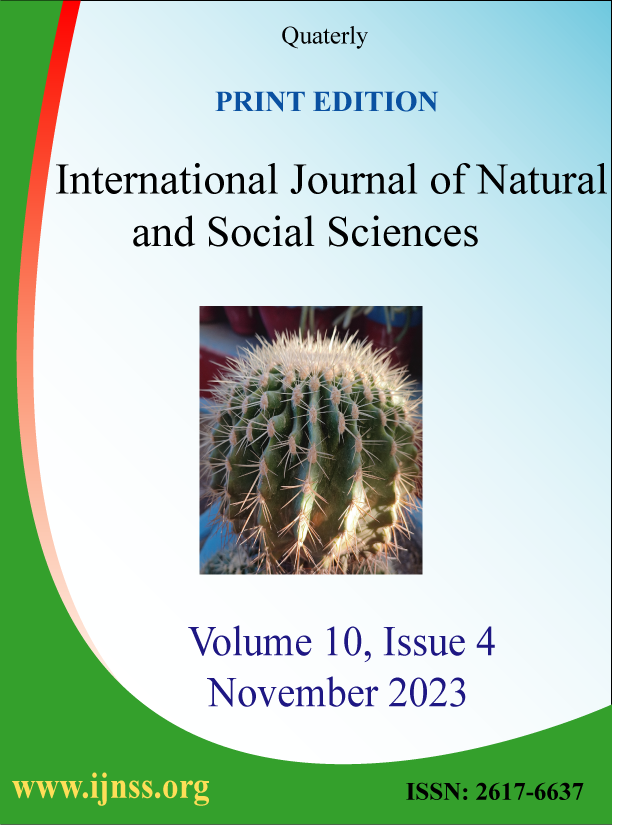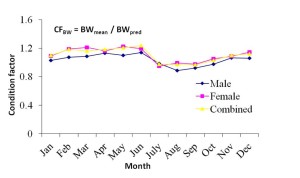Evaluation of condition factor of a small indigenous freshwater prawn, Macrobrachium lamarrei (H. Milne-Edwards, 1837) in Bangladesh
M Gulshan Ara, M Noor Nobi, M Kaniz Fatema![]()
![]() , Z Faruque Ahmed
, Z Faruque Ahmed
Department of Fisheries Management, Bangladesh Agricultural University, Mymensingh – 2202, Bangladesh
| ABSTRACT | Get Full Text PDF |
The condition factor of a small indigenous freshwater prawn, Macrobrachium lamarrei (H. Milne-Edwards, 1837) was studied to evaluate the health status of the species sample over a calendar year. A total of 1018 specimens (485 males and 533 females prawn) were used in this study, where condition factor for male, female and combined prawn varied with months. In case of male, the highest condition index was found in June (1.141) and lowest was found in August (0.886), and for female, the highest condition index was obtained in May (1.221), and the lowest was in July (0.947). In the combined sex, the highest condition index was determined in June (1.235), and lowest value was in September (0.966). The study suggested that both male and female individuals of the prawn population M. lamarrei were fatty in May and June; on the other hand, they appeared in lean condition in July and August over a calendar year.
Key words: Condition factor, freshwater prawn, Macrobrachium lamarrei, Bangladesh
![]() Corresponding author. Tel.: +8801716717739
Corresponding author. Tel.: +8801716717739
E-mail address: kanizhossain@gmail.com (MK Fatema) Copyright@2014 Int. J. Nat. Soc. Sci. all right reserved.
How to cite this article: MG Ara, MN Nobi, MK Fatema and ZF Ahmed (2014). Evaluation of condition factor of a small indigenous freshwater prawn, Macrobrachium lamarrei (H. Milne-Edwards, 1837) in Bangladesh. International Journal of Natural and Social Sciences, 1(2): 71-76.
INTRODUCTION
Bangladesh has a very rich source of prawns and shrimps in the freshwaters, estuaries and the Bay of Bengal which is a vital source of foreign currency. Among 57 prawns including 37 salt water, 12 brackish water, and 7 freshwater, Macrobrachium lamarrei (H. Milne-Edwards, 1837) has lucrative importance due to its short life-span, faster growth, and it forms an extremely important component of the subsistence catch in Bangladesh inland waters. M. lamarrei is commonly known as “kuncho river prawn” and is a small indigenous freshwater prawn belonging to the family Palaemonidae, plentifully spread out in whole country in shallow water of beels, freshwater ponds and rivers round the year in the North-Western districts of Bangladesh (Ali et al. 1980; Kibria 1983). M. lamarrei is also found in Indo-west pacific regions. This is a popular prawn among low income group of people and served as food fish for nutritional security through protein supply at low cost.
The degree of well-being of a fish is expressed by condition factor. It is also known as ‘coefficient of condition’ as well as length-weight factor. It is an important fishery tool and an indicator of the general fish condition which is based on the hypothesis that heavier fish of a given length are in fatty condition (Bagenal and Tesch, 1978). Bakare (1970) and Fagade (1979) reported that with increase in length of fish, condition factor decrease and it also influences the reproductive cycle in fish (Welcome, 1979). This factor is a measurement of a number of different biological and ecological aspects such as degree of fitness, gonad development and the suitability of the environment with regard to the feeding condition (Mac Gregoer, 1959). It also acts as an index of growth and feeding intensity (Fagade, 1979) i.e. when the fish has attained a better condition the value of condition factor is higher. A number of factors such as stress, sex, season, availability of feeds, and other water quality parameters affect the condition factor of fishes (Khallaf et al.., 2003). Environmental factors specially affect the fish body condition, growth performance and yield. Condition factor is also known as ponderal index or condition index. In Bangladesh, there is hardly any work that has been conducted on determination of condition factor of this valuable prawn species. Recently, fisheries biologists and fishers are paying significant attention to this prawn fishery due to their greater commercial prominence. There is insufficient information on prawn biology and lack of scientific work on M. lamarrei prawn diversity in Bangladesh. The aim of the present study is to assess the monthly variation of condition factor for male, female and combined population of M. lamarrei separately for understanding the health status and life cycle of this prawn species. Therefore, the present findings will provides baseline information for the condition factor of this species, and the data and information may assist as a tool for management initiatives for the sustainability of this freshwater prawn as well as other prawn species in Bangladesh and conservation practices.
MATERIALS AND METHODS
Sample collection
lamarrei prawn species was collected randomly using a fine-meshed push net from the L-shaped pond situated in Bangladesh Agricultural University campus, Mymensingh, Bangladesh once in a month over a calendar year.. All specimens were preserved in 10% buffered formalin soon after collection. Carapace lengths (CL) of all specimens as the distance from the tip of the rostrum to the posterior edge of the carapace were measured with a slide calipers to the nearest 0.01 mm, whilst body weight (BW) was taken with a digital balance to the nearest 0.01 g. Detailed description of prawn sampling is given in Table 1.
Table 1
Collection record of freshwater prawn M. lamarrei from L-shaped pond at Bangladesh Agricultural University (BAU), Mymensingh.
| Sampling month | Number of Male | Size Range | Number of Female | Size Range | ||
| CL (mm) | BW (g) | CL (mm) | BW (g) | |||
| January | 39 | 5.75-16.00 | 0.18-2.36 | 48 | 4.80-15.60 | 0.11-2.36 |
| February | 26 | 10.00-18.00 | 0.76-3.60 | 41 | 6.68-15.14 | 0.45-2.50 |
| March | 37 | 6.22-18.48 | 0.32-4.08 | 24 | 11.05-18.29 | 1.10-3.98 |
| April | 42 | 9.80-19.10 | 0.81-4.76 | 32 | 9.70-15.15 | 0.86-2.51 |
| May | 43 | 10.93-17.31 | 1.07-3.65 | 34 | 5.89-16.05 | 0.22-2.52 |
| June | 26 | 6.78-18.92 | 0.30-4.64 | 39 | 7.63-15.45 | 0.41-2.73 |
| July | 35 | 8.24-15.66 | 0.41-2.82 | 53 | 9.22-15.35 | 0.46-2.65 |
| August | 43 | 7.12-15.35 | 0.25-2.11 | 71 | 7.00-15.50 | 0.21-2.44 |
| September | 44 | 6.00-15.30 | 0.17-2.11 | 53 | 8.30-15.80 | 0.31-2.83 |
| October | 55 | 6.00-13.10 | 0.17-1.38 | 51 | 5.00-13.80 | 0.10-1.93 |
| November | 41 | 6.40-18.00 | 0.34-3.53 | 34 | 7.60-17.10 | 0.42-3.17 |
| December | 54 | 7.00-15.00 | 0.26-2.20 | 53 | 8.00-17.00 | 0.46-3.56 |
| Over a year | 485 | 533 | ||||
Sex determination
Male was identified observing second chelate legs which were extraordinary large, spiny and strong with naked eyes. Individuals confirmed as female with the presence of one pair of genital pore in the coax of third pairs of walking legs under a stereo microscope.
Length-weight relationship (LWR)
The relationship between carapace length and body weight was established using the equation, BW = aCLb. The equation is converted to its logarithmic expression: lnW = lna + b lnCL where the parameters lna and b were obtained from linear regression.
Determination of condition factor
The generalized length-weight relationship was constructed from the pooled CL-BW data of all monthly samples collected over the study period. To determine condition factor of the individuals at a particular month, the mean body weight (BWmean) of all individuals in a monthly sample was compared with the predicted mean body weight (BWpred.) at the mean carapace length of the prawns at the same month. The equation, therefore, is of the form as CFBW = BWmean / BWpred. The predicted mean body weight (BWpred.) at the mean carapace length of a particular month was calculated using the generalized length-weight relationships.
RESULTS AND DISCUSSION
For better prawn management, condition factor can play a vital role because they provide information of the specific condition under which organisms are developing to the prawn producer (Araneda et al.., 2008). According to Le Cren (1951), condition factor expressed the recent physical and biological developments which may vary by interaction among feeding conditions, physiological factors as well as parasitic infections. A total of 1018 specimens of M. lamarrei were used to evaluate condition factor where 485 were males and 533 were female prawn showing a sex ratio 1: 1.09 (male: female). The carapace length and body weight of all monthly samples collected all over the year varied and ranged from 4.80 mm to 19.10 mm and from 0.10 g to 4.76 g respectively. The carapace length and body weight of male ranged from 5.75 mm to 19.10 mm and from 0.17 g to 4.76 g respectively. And the carapace length and body weight of female ranged from 4.80 mm to 18.29 mm and the body weight ranged from 0.08 g to 3.98 g (Table 1).
The seasonal variations in conditions occurred in male, female and combined prawn were determined in this study (Table 2). Based on CFBW, monthly condition factors were determined and it ranged from 0.886 to 1.141 for male, from 0.949 to 1.221 for female and from 0.966 to 1.235 for combined prawn, indicating that the prawns are in good condition as well as this result agrees with the finding of Kunda et.al. (2008) for Macrobrachium rosenbergii. They found the values of condition factor varied from 0.967 to 1.165, and the mean value of the same was recorded as 1.089. They also reported a small variation observed in the case of condition factor. In the case of prawn, that variation in the values of condition factor may also be attributed to the attainment of maturity similar to fish (Rao, 1967).
Table 2 illustrated that in case of male, the highest value (CF =1.141) was found in June and lowest value (CF =0.886) was found in August. In case of female, the highest value (CF =1.221) was found in May and lowest value (CF =0.949) was found in July. In case of combined prawn, the highest value (CF =1.235) was found in June and lowest value (CF =0.966) was found in September. Similar ranges of condition have also been reported in other species of Macrobrachium (Arimoro and Meye, 2007; Enin, 1994).
Figure 1 displayed the condition factor of male population was sharply increasing from January to April. Then it drastically decreased in May and again increased in June. Thereafter it again decreased in July and remained approximately same till December. Condition factor of female was poor in January but it drastically increased in February and remained approximately same till June. In July the condition factor for female decreased sharply and remained more or less similar till November but in December it again sharply increased. In case of combined prawn, condition factor was lower in January and sharply increased in February and remained same till June. Thereafter it gradually decreased in July and remained more or less similar till November but in December it again increased. Condition factor significantly varied between sexes which may be due to better environmental conditions in the habitat, food abundance, feeding regime, seasonal variation and higher weight of female gonad. Dineshbabu (2006) reported similar results of condition factor of male and female Metapenaeus monoceros from Bhidiya, India. Condition factor significantly varied in males and females of M. macrobrachion from great Kwa River, Nigeria was reported by Andem et al., (2013).
Table 2
Sex-wise monthly variation of condition factor of M. lamarrei according to CFBW
| Month | Sex | n | Mean CL
(mm) |
Mean BW
(g) |
General
a |
General b | BWpred | CFBW | Growth Inference |
| January | Male
Female Combined |
39
48 87 |
11.746
10.047 10.809 |
1.211
0.812 0.991 |
0.0009
0.0012 0.0010 |
2.8933
2.790 2.844 |
1.176
0.744 0.903 |
1.029
1.091 1.097 |
Fatty
Fatty Fatty |
| February | Male
Female Combined |
26
41 67 |
13.427
10.989 11.935 |
1.858
1.136 1.417 |
0.0009
0.0012 0.0010 |
2.8933
2.790 2.844 |
1.732
0.956 1.197 |
1.073
1.189 1.183 |
Fatty
Fatty Fatty |
| March | Male
Female Combined |
37
24 61 |
14.479
12.917 13.865 |
2.337
1.815 2.132 |
0.0009
0.0012 0.0010 |
2.8933
2.790 2.844 |
2.155
1.500 1.833 |
1.085
1.210 1.163 |
Fatty
Fatty Fatty |
| April | Male
Female Combined |
42
32 64 |
14.649
12.956 13.917 |
2.518
1.76 2.190 |
0.0009
0.0012 0.0010 |
2.8933
2.790 2.844 |
2.228
1.513 1.853 |
1.130
1.163 1.182 |
Fatty
Fatty Fatty |
| May | Male
Female Combined |
43
34 77 |
14.544
11.50 13.199 |
2.396
1.325 1.923 |
0.0009
0.0012 0.0010 |
2.8933
2.790 2.844 |
2.182
1.085 1.594 |
1.098
1.221 1.206 |
Fatty
Fatty Fatty |
| June | Male
Female Combined |
26
39 65 |
14.653
11.641 12.845 |
2.544
1.340 1.822 |
0.0009
0.0012 0.0010 |
2.8933
2.790 2.844 |
2.229
1.122 1.475 |
1.141
1.194 1.235 |
Fatty
Fatty Fatty |
| July | Male
Female Combined |
35
53 88 |
11.942
12.213 12.106 |
1.214
1.218 1.216 |
0.0009
0.0012 0.0010 |
2.8933
2.790 2.844 |
1.234
1.283 1.246 |
0.984
0.949 0.976 |
Lean
Lean Lean |
| August | Male
Female Combined |
43
71 114 |
10.923
11.642 11.371 |
0.845
1.115 1.013 |
0.0009
0.0012 0.0010 |
2.8933
2.790 2.844 |
0.953
1.123 1.043 |
0.886
0.993 0.971 |
Lean
Lean Lean |
| September | Male
Female Combined |
44
53 97 |
11.918
12.009 11.968 |
1.129
1.194 1.165 |
0.0009
0.0012 0.0010 |
2.8933
2.790 2.844 |
1.227
1.224 1.206 |
0.921
0.975 0.966 |
Lean
Lean Lean |
| October | Male
Female Combined |
55
51 106 |
9.956
9.356 9.667 |
0.710
0.641 0.677 |
0.0009
0.0012 0.0010 |
2.8933
2.790 2.844 |
0.729
0.610 0.657 |
0.974
1.051 1.029 |
Lean
Fatty Fatty |
| November | Male
Female Combined |
41
34 75 |
11.661
11.015 11.368 |
1.227
1.046 1.145 |
0.0009
0.0012 0.0010 |
2.8933
2.790 2.844 |
1.152
0.962 1.042 |
1.065
1.087 1.098 |
Fatty
Fatty Fatty |
| December | Male
Female Combined |
54
53 107 |
11.719
11.889 11.803 |
1.234
1.363 1.298 |
0.0009
0.0012 0.0010 |
2.8933
2.790 2.844 |
1.168
1.190 1.159 |
1.057
1.145 1.119 |
Fatty
Fatty Fatty |
Monthly variation of condition factor of male, female and combined M. lamarrei according to CFBW.
In the present study sex wise comparison revealed higher value of condition factor in female compared to male in some months and vice-versa. Hossain et al. (2012) also found better condition factor of M. malcolmsonii in females than males in Ganges River, Bangladesh. Minimum and maximum values for male and female populations were computed as 0.33-0.99 and 0.3-1.8 and results suggest that M. malcolmsonii in the lower Indus river are in good condition. However, Abohweyere and Williams (2008) and Arimoro and Meye (2007) observed higher condition factor in male of M. macrobrachion compared to female and suggested that males generally appear to have better mean condition factor than the females. The differences between sex wise comparisons in different months may occur due to reproductive season, food availability and the presence of ovigerous females (Hossain et al., 2012) in the sample during study period.
Finally, the present results revealed that condition factor of M. lamarrei prawn species may be considered as a reliable indicator and knowledge on condition factor which is essential for assessment, sustainable prawn management and provides guidance to the future researcher in carrying out further detail study on other prawn species of Bangladesh.
REFERENCES
Abohweyere PO and Williams AB (2008). Length-weight relationship and condition factor of Macrobrachium macrobrachion in the Lagos-Lekki Lagoon system, Nigerian Research Journal of Biological Science, 3(11): 1333-1336.
Ali S, Chowdhury AN and Ray AR (1980). Ecology and seasonal abundance of zooplankton in a pond in Tongi, Dacca. Bangladesh Journa of Zoology, 8(1), 41-48.
Andem AB, Idung JU, Eni George E and Ubong GU (2013). Length-weight relationship and Fulton’s Condition Factor of brackish river prawn (Macrobrachium macrobrachion, Herklots, 1851) from Great Kwa River, Obufa Esuk beach, Cross River state, Nigeria. European Journal of Experimental Biology, 3(3):722-730.
Araneda M, Pérez EP and Gasca-Leyva E (2008). White shrimp Penaeus vannamei culture in freshwater at three densities: Condition state based on length and weight. Aquaculture, 283: 13–18.
Arimoro, FO and Meye, JA (2007). Some aspects of the biology of Macrobrachium dux (lenz, 1910) (crustacea: decapoda: natantia) in river Orogodo, Niger delta, Nigeria. Acta Biológica Colombiana, 12(1): 111 – 122.
Bagenal TB and Tesch AT (1978). Conditions and growth patterns in freshwater habitats. Blackwell Scientific Publications, 75 -89.
Bakare O (1970). Bottom deposits as food of Inland fresh water fish. In: Kainji, A Nigerian man-made lake. SA Visser, (Ed.). Kanji Lake Studies. Ecology Published for the Nigerian Institute, 65-85.
Dineshbabu, AP (2006). Length-weight relationship and growth of the speckled shrimp Metapenaeus monoceros (Fabricius) off Saurashtra. Journal of Marine Biolology Ass. India. 48 (2): 180 – 184.
Enin U (1994). Length–weight parameters and condition factor of two West African prawns. Review of Hydrobiologia Tropica, 27: 121–127.
Fagade SO (1979). Observation of the biology of two species of Tilapia from the Lagos lagoon Nigeria. Bulletin of Institutional Fondation of Africa Nore. 41: 627-658.
Hossain MY, Ohtom J, Jaman A, Saleha J and Robert LVJ (2012). Life history traits of the Monsoon River prawn Macrobrachium malcolmsonii (Milne-Edwards, 1844) (Palaemonidae) in the Ganges (Padma) River, northwestern Bangladesh. Journal of Freshwater Ecology, 27: 131-142.
Khallaf E, Galal M, and Athuman M (2003). The biology of Oreochromis niloticus in a polluted canal. Ecotoxicology, 12:405-416.
Kibria G (1983). Bangladesher Chingri Sampad O Chingri Chas (Shrimp fishery and shrimp culture). Jahan Printing Press, Satkhira, Khulna, 126 pp.
Kunda, M, Dewan, S, Uddin, MJ, Karim, M, Kabir, S and Uddin, MS. (2008). Length-Weight relationship, condition factor and relative condition factor of Macrobrachium rosenbergii in rice fields. Asian Fish Science, 21: 451-456.
Le Cren ED (1951). The length-weight relationship and seasonal cycle in gonad weight and condition in the perch Perca fluviatilis. Journal of Animal Ecology, 20:201-219.
Mac Gregoer JS (1959): Relation between fish condition and population size in the sardine (Sardinops cacrulea). Fish Bulletin, 60:215-230.
Parween S 1982. Studies on some aspects of fisheries of freshwater prawns, Macrobrachium dayanum (Hend) of Rajshahi district. M. Phil. Thesis (unpublished). Department of Zoology, University of Rajshahi, 158 pp.
Rao RM 1967. Studies on the biology of Macrobrachium rosenbergii (De Man) of the Hoogly estuary with notes of its fishery. Proceedings of National Institute of Science, India. Part. Biological. Science, 33(5&6): 252-279.
Welcome RL 1979: Fisheries ecology of Floodplain Rivers. Longman Press, London. pp 317.







